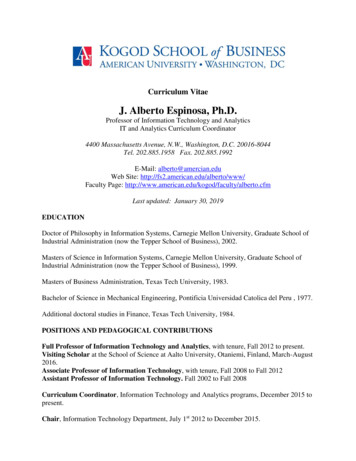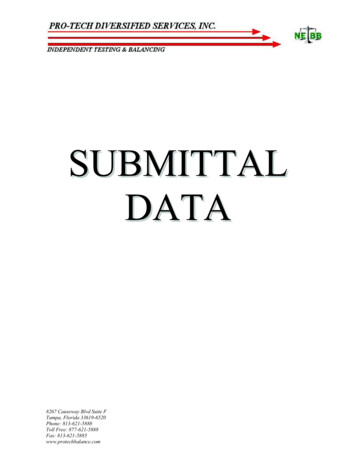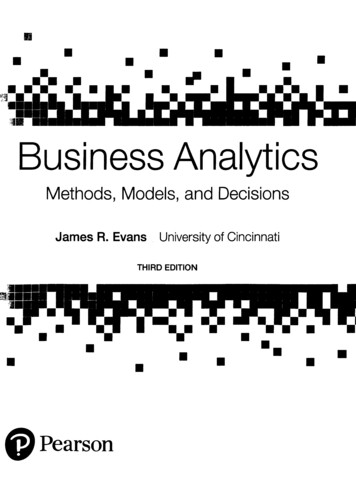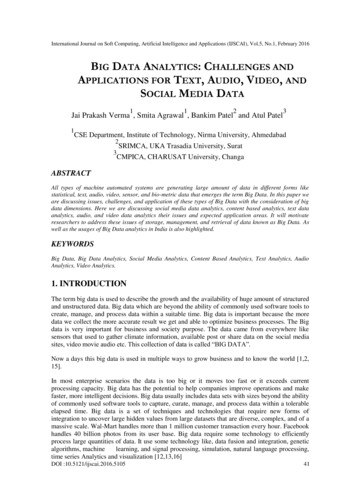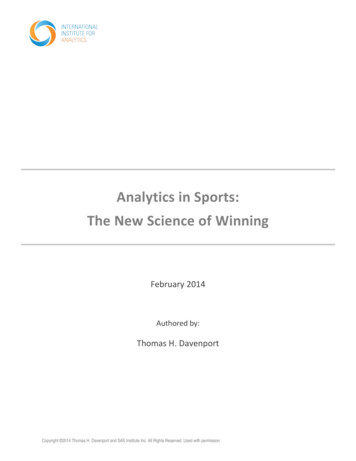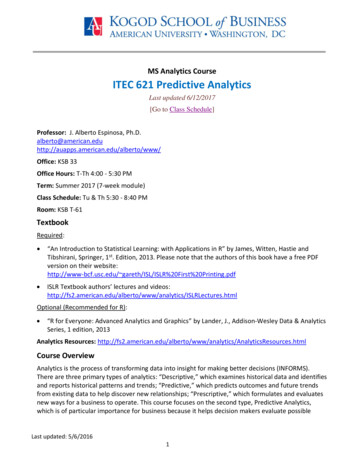
Transcription
MS Analytics CourseITEC 621 Predictive AnalyticsLast updated 6/12/2017[Go to Class Schedule]Professor: J. Alberto Espinosa, u/alberto/www/Office: KSB 33Office Hours: T-Th 4:00 - 5:30 PMTerm: Summer 2017 (7-week module)Class Schedule: Tu & Th 5:30 - 8:40 PMRoom: KSB T-61TextbookRequired: “An Introduction to Statistical Learning: with Applications in R” by James, Witten, Hastie andTibshirani, Springer, 1st. Edition, 2013. Please note that the authors of this book have a free PDFversion on their website:http://www-bcf.usc.edu/ gareth/ISL/ISLR%20First%20Printing.pdf ISLR Textbook authors’ lectures and cs/ISLRLectures.htmlOptional (Recommended for R): “R for Everyone: Advanced Analytics and Graphics” by Lander, J., Addison-Wesley Data & AnalyticsSeries, 1 edition, 2013Analytics Resources: yticsResources.htmlCourse OverviewAnalytics is the process of transforming data into insight for making better decisions (INFORMS).There are three primary types of analytics: “Descriptive,” which examines historical data and identifiesand reports historical patterns and trends; “Predictive,” which predicts outcomes and future trendsfrom existing data to help discover new relationships; “Prescriptive,” which formulates and evaluatesnew ways for a business to operate. This course focuses on the second type, Predictive Analytics,which is of particular importance for business because it helps decision makers evaluate possibleLast updated: 5/6/20161
outcomes (e.g., revenues, profits, marketshare, probability of making a sale, probabilityof losing a client, etc.) based on otherhistorical data predictors (e.g., marketingexpenditures, quality assurance investments,sales force size, etc.). The process of analyticsinvolves specifying a question, problem, ordecision, and finding the right answers usingdata. The process begins with identifying theappropriate data sources (internal or external,data format), and the appropriate models,tools, and methods for analysis. In thiscourse, students are introduced to predictive modeling methods, approaches and tools. Studentsdevelop skills in predictive analytics that will allow them to: (1) develop and use advanced predictiveanalytics methods; (2) develop expertise in the use of popular tools and software for predictiveanalytics; (3) learn how to develop predictive analytics questions, identify and select the mostappropriate predictive analytics methods and tools, apply these methods to answer the respectivequestions and presenting data-driven solutions.Course Learning ObjectivesAfter completing this class, the student will develop the following competencies. Competency-1: Predictive Analytics Methods Ability to apply specific statistical and regression analysis methods applicable to predictiveanalytics to identify new trends and patterns, uncover relationships, create forecasts, predictlikelihoods, and test predictive hypotheses. Ability to develop and use various quantitative and classification predictive models based onvarious regression and decision tree methods. Competency-2: Predictive Analytics Tools Develop familiarity with popular tools and software used in industry for predictive analytics,especially R, R Studio and R Markdown. Competency-3: The Predictive Analytics Cycle Understanding of how to formulate predictive analytics questions. Learn how to select the appropriate method for predictive analysis, and how to build effectivepredictive models. Learn how to search, identify, gather and pre-process data for the analysis. Learn how to evaluate the soundness, appropriateness and validity of their models and how tointerpret and report on results for a management audience.Student Requirements and ResponsibilitiesLast updated: 5/6/20162
Students need to be familiar with this syllabus and the weekly class schedule below. All assignmentsand class events will be posted either in the class schedule or on Blackboard.Similarly, students need to check all announcements posted on Blackboard before each class.Students are required to check their American University e-mail regularly for class announcements.Students who do not use their AU e-mail regularly need to either forward their AU e-mail to theirpersonal e-mail accounts or change their e-mail address in Blackboard.Students are required, per University policy, to be familiar with AU's Academic Integrity Policy.Please read carefully the policies and read the Academic Integrity Policy section below. Thesepolicies will be strictly enforced in this course.Students are required to read all assigned material prior to class, prepare for class as instructed,participate actively in class discussion, and take a proactive role to maximize their learning from thisclass and in helping others benefit from the course. Students must read the assigned materialbefore class and review the R code and related instructions before the corresponding R sessions.A good portion of the class lectures will come from sources other than the textbooks. Therefore,this class requires regular attendance and consistent week-to-week commitment on the part of thestudent. The material in this course is sequential in nature, so missing a lecture will not only affectthe student's learning on the missed lecture, but also on subsequent material covered.Grading StructureCourse Component4 HomeworkExamTerm projectQuizzes and class exercisesAttendance and participationTotalWeightComposition20% (4 @ 5% l or TeamIndividualIndividualGrading Legend:A: 93 or above; A-: 90 to less than 93;B : 88 to less than 90; B: 83 to less than 88; B-: 80 to less than 83;C : 78 to less than 80; C: 73 to less than 78; C-: 70 to less than 73;D: C-: 60 to less than 70;F: less than 60.Course Components (all work in this course is individual)1. Homework: 4 homework assignments on predictive analytics modeling. The homework will focuson hands-on use of R software to develop predictive models. The homework will be prepared in RMarkdown and submitted as an HTML file (Produced by knitr HTML from R Markdown).2. Exam: There one in-class exam towards the end of the semester. The exam will be conceptual. Theexams will aim at testing your ability to process various business scenarios/problems/questions andLast updated: 5/6/20163
select and justify specific predictive modeling method. The exam covers all lectures and ISLRtextbook readings up to and including the last class. R coding will not be covered in the exam butyou need to be able to interpret plots and other outputs I prepared in R. In each question you will bepresented with an analytics scenario. This scenario will contain one or more of the following:2.1. A particular problem to resolve or business question to answer with predictive analytics(important note: your goal will NOT be to solve the problem or answer discussion, but todiscuss your approach to do that);2.2. An analysis goal (i.e., interpretation, inference or prediction); and2.3. Relevant exhibits, which may include things like: model summary outputs; plots; distributions;data descriptions or displays. I will not ask any questions on R coding, but I will include a few Rplots and outputs for interpretation. Each question will require a short, concise and preciseanswer demonstrating your knowledge of the material understanding of the specifics of thescenario, rather than long essays with vague generalities.3. Term Project: The project will be done in teams of maximum 3 students. Students are alsowelcomed to work in pairs or even individually. For students working in teams, it is expected that allteam members will contribute equally and that everyone will take the opportunity to learn fromeach other. Students will identify a business problem to address through predictive analytics. Thegoal is to select appropriate models and model specifications, and apply the respective methods toenhance data-driven decision making related to the business problem. Students will identifypotential use of predictive analytics, formulate the problem, identify the right sources of data,analyze data, and prescribe actions to improve not only the process of decision making but also theoutcome of decisions. See further instructions on Blackboard.4. Quizzes and Class Exercises: You will complete several quizzes and class exercises during thesemester. The quizzes will be short (10 minutes or so) based either on assigned material or onmaterial already covered in class. The class exercises will involve short R assignments in class. Therewill be 8 to 10 quizzes and/or exercises during the semester. The lowest grade will be dropped fromyour average. So try not to miss more than one of these.5. Class attendance, participation and exercises: Attendance is a straight percentage of the classesyou attended, adjusted for lateness and early departures; In-class participation is measured by theability of students to bring quality discussion into the class. This course is based on a model ofactive learning, with class discussions and exercises playing a central role. Students are expected toread the assigned material and to carefully prepare for all cases and exercises before coming to classand completing the required class exercises, when assigned. Students will be called upon to respondLast updated: 5/6/20164
to faculty questions. This course is very hands-on and the only way to learn the material well isthrough intensive exercises. About 50% of the class will be focused on hands on demonstrations andgraded exercises.Class ScheduleNote: The textbook authors have a nice series of video lectures where they narrate the book themselves.While these videos are not required, they really help understand the readings. You can find all the videolectures associated with each chapter at:http://auapps.american.edu/ dent LearningObjectivesTopic(R) Readings; (HW) Homework;(E) Exam; (P) Project; (V) WatchVideo Lecture; (o) Other1ATu5/16Develop a deepunderstanding of thepredictive analytics lifecycle and severalfoundational concept thatwill be used throughoutthe course.1. Introduction Syllabus Overview Course Introduction The Analytics Life Cycle Introduction to Predictive Analytics Matrix Notation Basic Foundations (B) Model, Method and FeatureSelectionAll authors’ slides and videolectures available s/ISLRLectures.html(R) ISLR Ch.1 Introduction(V) ISLR Ch.1(O) Download and install Rand R Studio1BTh5/18Overview of R forPredictive Modeling2. R Refresher(R) ISLR 2.3 Lab: Introductionto R(O) Recommended R book: Rfor EveryoneOverview of basicstatistics and theOrdinary Least Squares(OLS) regression model2ATu5/23Further insights into theOLS regression model andits assumptions andlimitations. Exploring thefirst departure from OLSdue to heteroscedasticityWLS. Taking a first look atGLM3. Regression Refresher Covariance, Correlation and ANOVAreview. Simple Linear Regression OLS Model Diagnostics3. Regression Refresher (cont’d.) Dummy Variables Multivariate Regression OLS Assumptions Weighted Least Squares (WLS) Generalized Linear Models (GLM)Last updated: 5/6/20165(R) ISLR Ch.3 LinearRegressionHW1 DueR Practice
2BTh5/25Learning to work withvarious data types andhow to pre-process thedata for analysis,including populartransformations like BoxCox, standardized data,log transformations andlagging time series data.3ATu5/304. Data Pre-Processing Overview Variable Types Introduction to Data Transformations Data Transformations:1. Categorical to Dummy Variables2. Polynomials3. Box-Cox Transformation4. Data Pre-Processing (cont.d)4. A) Log & Elasticity ModelsB) Logit Transformation5. Count Data Models6. Centering7. Standardization3BTh6/14.Data Pre-Processing (cont.d)8. Rank Transformations9. Lagging Data (Causal Models)10. Data Reduction(R) ISLR Ch.2 StatisticalLearning(R) ISLR 5.1 Cross-ValidationHW2 Due4ATu6/6Learning the basicconcepts behind“machine learning” andthe various ways ofevaluating the predictiveaccuracy of models.5. Machine Learning Machine Learning Overview Bias vs. Variance Tradeoff Error Measures Cross-Validation4BTh6/8Learning how to selectthe number of predictorsin a model and addressissues of dimensionality,like multi-collinearity.6. Variable Selection Dimensionality Issues Multi-Collinearity Variable Selection Methods Step Methods(R) ISLR Ch.6.1 Linear ModelSelectionLearn how to buildpredictive models whenthe relationship betweenthe predictors and theoutcome variable don’tappear to follow a lineartrend.7. Non-Linear Models Non-Linearity Overview Interaction Models Polynomial Models Step Models Piecewise Models Piecewise Linear Models Piecewise Polynomial Models Spline (MARS) Models(R) ISLR Ch.7 Beyond Linearity5ATu6/13Last updated: 5/6/20166HW3 Due(P) Term ProjectProposal Due
5BTh6/156ATu6/20Learn how to buildpredictive models whenthe outcome is binary(e.g., yes/no,success/failure,approve/decline), usingpopular methods likelogistic regression anddiscriminant analysis.8. Classification Models Introduction Binomial Logistic Regression Multinomial Logistic Regression Linear Discriminant Analysis Quadratic Discriminant AnalysisLearn the variousmethods to buildpredictive classificationmodels using decisiontrees, rather thanregression models.10. Decision Trees Decision Trees Regression Trees Growing Trees Regression Tree Issues Classification Trees Pruning Trees Bootstrap Aggregation (Bagging) Random Forest Models(R) ISLR Ch.4 ClassificationHW4 Due(R) ISLR Ch.8 Tree-BasedMethodsReview for Exam6BTh6/227ATu6/27Exam (up to and including 8 above)Learning how to handlepredictive with largenumber of predictors,and how to reduce theset of predictors usingregularization, penalizedmodels and otherdimension reductionmethods like principalcomponents and partialleast squares.9. Dimensionality (D) Regularization (Penalized orShrinkage Models) Ridge Regression LASSO (D) Dimension Reduction Models Principal Components Regression(PCR) Partial Least Squares (PLS)(R) ISLR Ch.6.2 ShrinkageMethodsModel/Method Selection ReviewFly SoloReviews for Term ProjectCourse Wrap-Up7BTh6/29Project Reports in ClassLast updated: 5/6/20167(P) Term Project DueIN CLASS
Academic Integrity CodeAcademic integrity is paramount in higher education and essential to effective teaching and learning.As a professional school, the Kogod School of Business is committed to preparing our students andgraduates to value the notion of integrity. In fact, no issue at American University is more serious oraddressed with greater severity than a breach of academic integrity.Standards of academic conduct are governed by the University’s Academic Integrity Code. By enrollingin the School and registering for this course, you acknowledge your familiarity with the Code and pledgeto abide by it. All suspected violations of the Code will be immediately referred to the Office of theDean. Disciplinary action, including failure for the course, suspension, or dismissal, may result.Additional information about the Code (i.e. acceptable forms of collaboration, definitions of plagiarism,use of sources including the Internet, and the adjudication process) can be found in a number of placesincluding the University’s Academic Regulations, Student Handbook, and website at http://www.american.edu/academics/integrity . If you have any questions about academic integrityissues or about standards of conduct in this course, please discuss them with your instructor.Academic Support ServicesIf you experience difficulty in this course for any reason, please don’t hesitate to consult with me. Inaddition to the resources of the department, a wide range of services is available to support you in yourefforts to meet the course requirements.Academic Support Center (x3360, MGC 243) offers study skills workshops, individual instruction, tutorreferrals, and services for students with learning disabilities. Writing support is available in the ASCWriting Lab or in the Writing Center, Battelle 228.Counseling Center (x3500, MGC 214) offers counseling and consultations regarding personal concerns,self-help information, and connections to off-campus mental health resources.Disability Support Services (x3315, MGC 206) offers technical and practical support and assistance withaccommodations for students with physical, medical, or psychological disabilities. If you qualify foraccommodations because of a disability, please notify me in a timely manner with a letter from theAcademic Support Center or Disability Support Services so that we can make arrangements to addressyour needs.Kogod Center for Business Communications (x1920, KSB 101) To improve your writing, public speaking,and team assignments for this class, contact the Kogod Center for Business Communications. You canget advice for any written or oral assignment or for any type of business communication, includingmemos, reports, individual and team presentations, and PowerPoint slides. Hours are flexible andinclude evenings. Go to http://www.kogod.american.edu/cbc and click on "make an appointment," visitKSB 101, or email cbc@american.edu. You may also call x1920.Last updated: 5/6/20168
Financial Services and Information Technology Lab (FSIT) (x1904, KSB T51) to excel in your course workand to maximize your business information literacy in preparation for your chosen career paths, westrongly recommend to take advantage of all software applications, databases and workshops in theFSIT Lab. The FSIT Lab promotes action-based learning through the use of real time market data andanalytical tools used by business professionals in the market place. These include Bloomberg, ThomsonReuters, Argus Commercial Real Estate, Compustat, CRSP, @Risk etc. For more information, pleasecheck out the website at Kogod.american.edu/fsit/ or send us an email to fsitlab@american.edu.EMERGENCY PREPAREDNESS FOR DISRUPTION OF CLASSESIn the event of an emergency, American University will implement a plan for meeting the needs of allmembers of the university community. Should the university be required to close for a period of time,we are committed to ensuring that all aspects of our educational programs will be delivered to ourstudents. These may include altering and extending the duration of the traditional term schedule tocomplete essential instruction in the traditional format and/or use of distance instructional methods.Specific strategies will vary from class to class, depending on the format of the course and the timing ofthe emergency. Faculty will communicate class-specific information to students via AU e-mail andBlackboard, while students must inform their faculty immediately of any absence. Students areresponsible for checking their AU e-mail regularly and keeping themselves informed of emergencies. Inthe event of an emergency, students should refer to the AU Student Portal, the AU Web site(http://www.american.edu/emergency/) and the AU information line at (202) 885-1100 for generaluniversity-wide information, as well as contact their faculty and/or respective dean’s office for courseand school/ college-specific information.Last updated: 5/6/20169
analytics methods; (2) develop expertise in the use of popular tools and software for predictive analytics; (3) learn how to develop predictive analytics questions, identify and select the most appropriate predictive analytics methods and tools, apply these methods to answer the respective questions and presenting data-driven solutions. Course .
